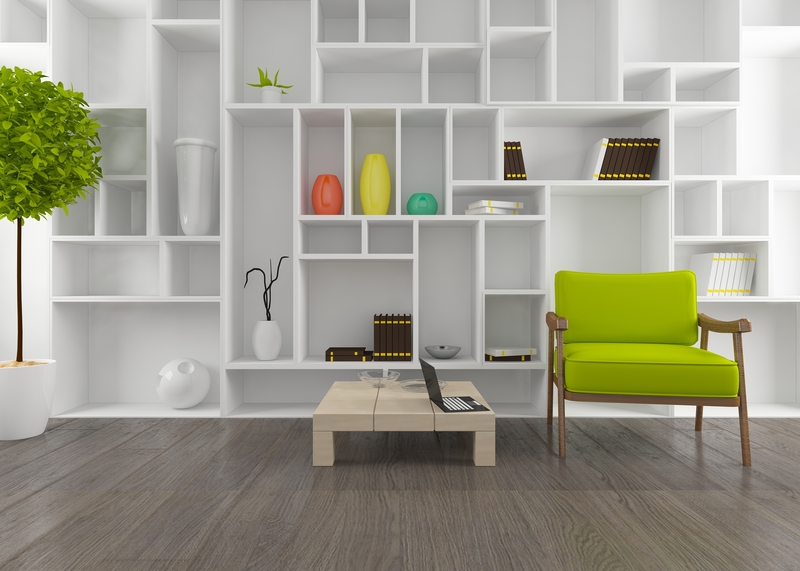Secure Your Sofa's Future: Industry-Recommended Storage Insights
When it comes to furniture, your sofa is often the heart of your living space. Preserving its comfort, style, and structural integrity is vital whether you're moving, redecorating, or simply storing it for future use. If you're wondering how to secure your sofa's future with proven storage methods, you've come to the right place. This comprehensive guide reveals the industry's best storage practices, guaranteeing that your beloved sofa remains in top-notch condition for years to come.

Why Proper Sofa Storage Matters
Many homeowners overlook the importance of proper sofa storage. However, inadequate storage can lead to:
- Deterioration of upholstery fabric
- Breakdown of cushioning and internal supports
- Mold, mildew, and pest infestation
- Permanent stains and odors
- Structural warping or cracks
Investing in the long-term preservation of your sofa is both a savvy financial move and a way to protect the memories made upon it. Let's explore the industry-recommended steps to secure your sofa's future with effective storage solutions.
Assess the Condition of Your Sofa Before Storage
Before you jump into storing your sofa, evaluate its current condition. Addressing minor repairs, cleaning, and prepping the sofa are all essential steps:
1. Inspect for Damage
- Tighten any loose screws, bolts, or joints.
- Check for broken legs, frame cracks, or sagging springs.
- Repair damage to prevent further deterioration during storage.
2. Clean Thoroughly
- Vacuum all crevices, under the cushions, and along the seams to remove debris and prevent pests.
- Spot-clean stains using manufacturer-approved products.
- Steam clean or professionally clean the upholstery and any wood or metal accents.
3. Disassemble If Possible
- Remove legs, cushions, or armrest components to minimize space and protect delicate parts.
- Label and store screws in sealed bags taped to corresponding components.
Proper preparation is your first line of defense in extending the lifespan of your sofa in storage.
Choose the Right Storage Facility
Your choice of storage facility can make or break your sofa's future. Consider these industry-leading recommendations:
Climate-Controlled Storage is a Must
- Climate control maintains consistent temperature and humidity, preventing mold, mildew, and wood warping.
- Extreme temperatures can cause upholstery to fade, crack, or attract pests. Don't skimp on climate-controlled self-storage.
Choose a Clean, Secure Facility
- Ensure the facility enforces strict pest control measures.
- Verify security features like CCTV, alarms, and controlled access.
- Confirm the storage unit is dry, ventilated, and leak-free.
Remember: Choosing the right facility means investing in your sofa's longevity.
How to Prepare Your Sofa for Safe Storage
Wrap and Protect
- Use furniture blankets or padded sheets to protect upholstery from dust, scratches, and sunlight.
- Never use plastic wrap directly on upholstery--it can trap moisture, causing mildew and rot. Instead, use breathable covers crafted for sofas.
- Double-wrap vulnerable corners and armrests for extra protection.
Elevate Your Sofa
- Place pallets or wooden planks beneath your sofa to prevent direct contact with the floor--especially vital in case of flooding or condensation.
- This elevation also deters pests and makes routine inspection easier.
Arrange for Proper Airflow
- Leave space around your sofa. Don't stack boxes or furniture against it, as this can trap moisture and encourage mold growth.
- Position vents or fans to aid air circulation, keeping humidity at bay.
Proper wrapping and positioning are key to securing your sofa's future in storage.
Industry Tips for Long-Term Sofa Storage
Monitor Temperature and Humidity
- Ideally, maintain a consistent temperature between 55?F and 75?F (13?C - 24?C).
- Relative humidity should stay below 55% to prevent microbial growth and wood swelling.
- Use a hygrometer to monitor moisture levels.
Regular Inspections
- Check your stored sofa every 2-3 months for signs of pests, moisture, or fabric deterioration.
- Ventilate the storage unit periodically to keep air fresh.
Don't Store Items on the Sofa
- Resist the urge to use your sofa as a shelf! Weight from boxes or bags can lead to indents, fabric stress, and frame damage.
Use Desiccants
- Place silica gel packs or moisture absorbers around and within your sofa to prevent dampness.
Keep Records
- Photograph your sofa before and after storage for insurance and condition tracking.
- Record cleaning and inspection dates.
By following these storage tips for sofas, you'll ensure your furniture is ready to reclaim pride of place in your living room when the time comes.
Common Sofa Storage Mistakes to Avoid
- Using plastic wraps directly on the textile--this traps condensation, leading to mold and odors.
- Piling heavy objects on the sofa--which causes warping or permanent cushion indentations.
- Storing in non-climate-controlled units--exposes your sofa to weather extremes, pests, and moisture.
- Ignoring regular inspections--minor problems can turn into major damage if unchecked for months.
- Neglecting cleaning before storage--dirt, oils, and crumbs can attract bugs and cause staining over time.
If you avoid these common mistakes, you'll go a long way in securing your couch's longevity.
Types of Sofas and Their Storage Needs
Not all sofas are alike. Here's how different types of seating require special attention in storage:
Leather Sofas
- Condition leather with manufacturer-approved products before storage to keep it supple.
- Avoid sunlight (even through windows) that can fade and crack the leather.
- Humidity is critical--too much can cause mildew, too little can dry and crack leather finishes.
Fabric Sofas
- Choose breathable covers and desiccants for extra moisture control.
- Store away from sharp objects to avoid accidental tears and snags.
Sectional Sofas
- Disassemble modular sections where possible and wrap each separately for maximum protection.
- Label each part for easy reassembly.
Sofabeds/Futons
- Disengage folding mechanisms to avoid tension on springs or joints during storage.
- Wrap mattresses separately with special covers designed for bedding.
By tailoring your approach based on your sofa's construction and materials, you'll secure its future wherever it's stored.
Special Considerations for Storing Sofas Long-Term
Insurance and Liability
- Insure valuable furniture pieces against damage or theft while in storage.
- Discuss limitations with your storage provider--some policies may not cover certain types of damage.
Professional Assistance
- Enlist professional movers experienced in furniture padding, transport, and arrangement within units to prevent mishandling.
- For fine antiques or delicate pieces, consult with restoration or preservation experts prior to storage.
Staging for Quick Access
- If you anticipate retrieving your sofa at short notice, place it near the entrance of your unit or maintain open paths to it.
Eco-Friendly Storage Practices
- Opt for reusable and sustainable covers and materials to minimize environmental impact.
- If discarding a damaged sofa, consider recycling or upcycling options.
How to Safely Retrieve and Reintegrate Your Sofa
When it's time to bring your sofa back, a few steps ensure it's ready for use:
- Unwrap carefully--inspect all surfaces, cushions, and framework for potential issues such as pest activity or moisture spots.
- Clean before use--give your sofa a thorough vacuum and wipe down, using a fabric or leather cleaner as appropriate.
- Allow time to breathe--let the sofa air out for several hours in a well-ventilated space before using it or placing it in your home.
- Check and re-tighten all bolts or screws if the sofa was disassembled.
Reintegrating your sofa gently ensures that its years in storage do not reduce its comfort or lifespan.

FAQs: All About Securing Your Sofa's Future With Storage
Is self-storage safe for expensive or antique sofas?
Yes--provided you choose a climate-controlled, high-security unit and properly handle all preparation and wrapping. Insurance is highly recommended for high-value pieces.
How long can I store my sofa safely?
If you follow industry-recommended storage procedures, your sofa can be stored for several years with minimal quality loss.
Can I use regular storage plastic bags or wraps?
No. Plastic bags can trap moisture and foster mold. Instead, use professional-grade breathable covers designed specifically for furniture storage.
Do I need special cleaning products for storage preparation?
Always use manufacturer-recommended, upholstery-safe, or leather-safe cleaning solutions before storing your sofa.
Will bugs and rodents attack my stored sofa?
If you clean your sofa thoroughly, use pest deterrents, and select a reputable, pest-controlled storage facility, you'll significantly reduce this risk.
Conclusion: Invest in Your Sofa's Longevity with Smart Storage
Your sofa is more than just a piece of furniture--it's the foundation of family gatherings, lazy Sunday afternoons, and countless memories. By following these industry-recommended sofa storage insights, you're ensuring that your sofa remains a cherished centerpiece for years to come. Remember to prepare, protect, and regularly inspect your sofa in storage, and always opt for climate-controlled, secure environments.
Secure your sofa's future by implementing these insightful tips and trusted techniques, and enjoy peace of mind knowing your investment is in safe hands--even when it's out of sight.
For more home storage solutions and expert advice, explore our additional guides and resources.
- Deep cleaning and damage inspection are crucial prep steps
- Climate-controlled units are non-negotiable for fabric or leather sofas
- Protective wrapping and airflow are must-dos for every storage scenario
- Frequent inspections and proper insurance give extra peace of mind
Secure your sofa's future--store it the right way, and it will serve you and your family for many years ahead!



